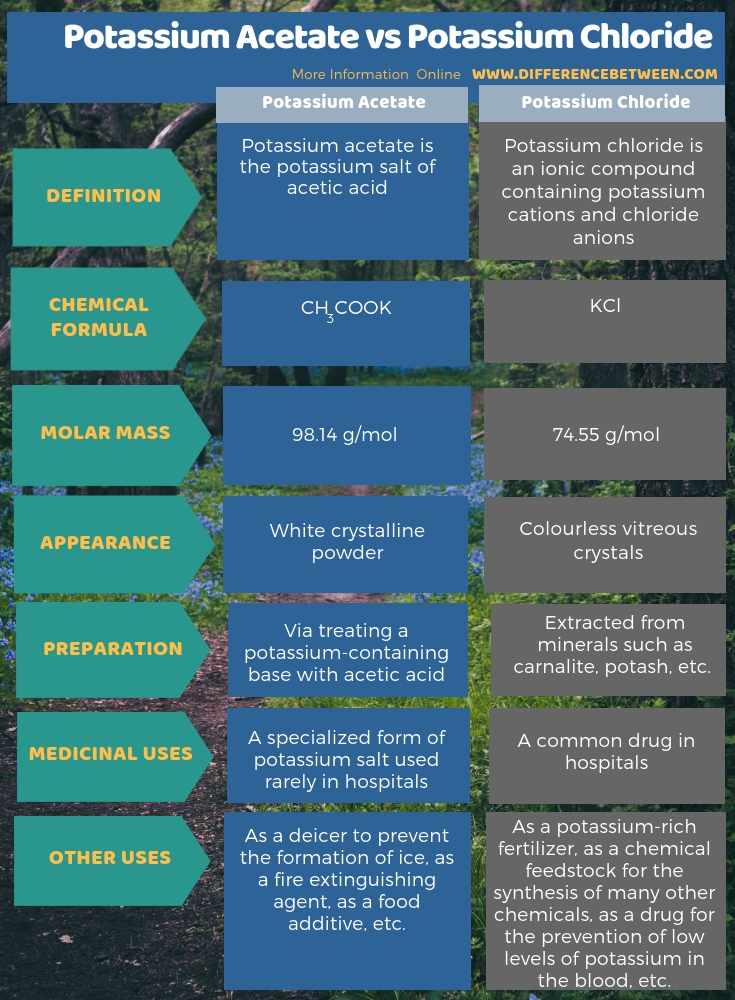Difference Between Potassium Acetate and Potassium Chloride
Table of Contents
The key difference between potassium acetate and potassium chloride is that potassium acetate is the potassium salt of acetic acid, whereas potassium chloride is a metal halide salt containing potassium and chloride ions.
Potassium acetate and potassium chloride are salt compounds and ionic compounds containing potassium ions combined with anions acetate and chloride, respectively. Potassium acetate is a specialized form of potassium salt rarely used in hospitals, but potassium chloride is a common drug in hospitals.
CONTENTS
1. Overview and Key Difference
2. What is Potassium Acetate
3. What is Potassium Chloride
4. Side by Side Comparison – Potassium Acetate vs Potassium Chloride in Tabular Form
5. Summary
What is Potassium Acetate?
Potassium acetate is the potassium salt of acetic acid. It has the chemical formula CH3COOK in which, K+ is potassium cation and CH3COO– is acetate anion. Moreover, the molar mass of this compound is 98.14 g/mol. It appears as a white crystalline powder. Further, this substance is deliquescent. The melting point is 292 °C, and upon further heating, the compound will decompose.

Figure 01: Structure of Potassium Acetate
Furthermore, we can prepare potassium acetate via treating a potassium-containing base with acetic acid. It is an acid-base neutralization reaction. Here, the most common bases include potassium hydroxide and potassium carbonate.
Moreover, there are many applications of potassium acetate. We can use it as a deicer to prevent the formation of ice. Also, it is useful as a fire extinguishing agent. Besides, it is also a food additive and used for the preservation of food. Although it has applications in medicine, the use of this compound in hospitals is rare.
What is Potassium Chloride?
Potassium chloride is an ionic compound containing potassium cations and chloride anions. It is a metal halide salt with the chemical formula KCl. The compound appears as colourless vitreous crystals and readily dissolves in water, dissociating into ions. Moreover, the aqueous solution has a salty taste.

Figure 02: Potassium Chloride
Concerning the usefulness, this compound is useful in agriculture as a potassium-rich fertilizer. It also has medicinal uses, especially to treat low blood potassium levels. Moreover, it is very useful as a chemical feedstock for the synthesis of potassium hydroxide and potassium metal.
What is the Difference Between Potassium Acetate and Potassium Chloride?
Potassium acetate and potassium chloride are ionic compounds composed of cations and anions. The key difference between potassium acetate and potassium chloride is that potassium acetate is the potassium salt of acetic acid, whereas potassium chloride is a metal halide salt containing potassium and chloride ions. Another difference between potassium acetate and potassium chloride is their appearance. Potassium acetate appears as a white crystalline powder while potassium chloride appears as colourless-vitreous crystals.

Summary – Potassium Acetate vs Potassium Chloride
Potassium acetate and potassium chloride are basically ionic compounds composed of cations and anions. The key difference between potassium acetate and potassium chloride is that potassium acetate is the potassium salt of acetic acid, whereas potassium chloride is a metal halide salt containing potassium and chloride ions.
Reference:
1. “Lethal Injections: Potassium Chloride vs. Potassium Acetate.” com, Oklahoman, 11 Oct. 2015, Available here.
Image Courtesy:
1. “Potassium acetate skeletal” By Edgar181 (talk) – Own work (Public Domain) via Commons Wikimedia
2. “Potassium chloride” (Public Domain) via Commons Wikimedia
ncG1vNJzZmivp6x7pbXFn5yrnZ6YsqOx07CcnqZemLyue8OinZ%2Bdopq7pLGMm5ytr5Wau268zq2YrKuZqrpurcKeq5qslWKur7CMqaatmaOotra5jJyfpaeinrGmew%3D%3D